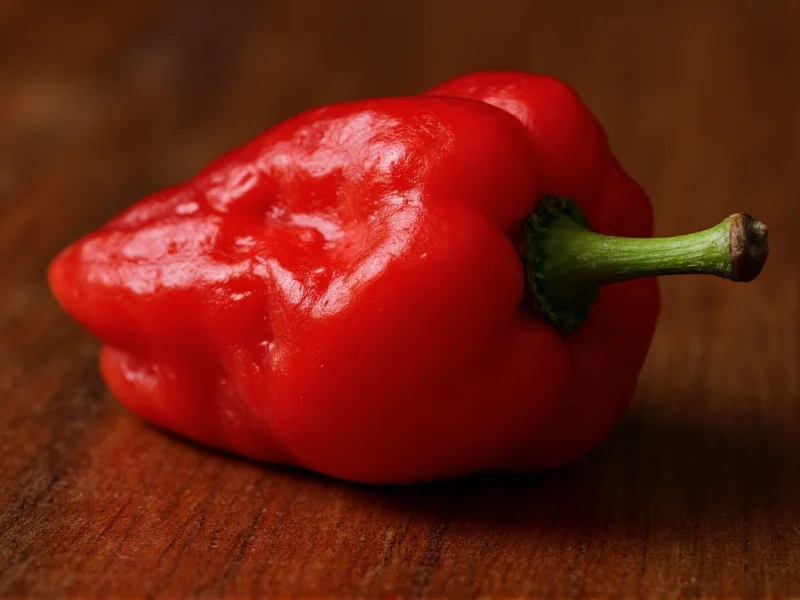The Scoville scale measures chili pepper heat intensity by determining capsaicin concentration—the compound responsible for spiciness. Understanding exactly how many scovilles in a ghost pepper requires examining both scientific testing methods and natural variations that affect heat levels.
Understanding Scoville Heat Unit Measurements
Developed by pharmacist Wilbur Scoville in 1912, the Scoville Organoleptic Test originally measured heat through human taste panels diluting pepper extract until heat became undetectable. Today, high-performance liquid chromatography (HPLC) provides precise capsaicinoid measurements, with results converted to Scoville units.
When researching how hot is a ghost pepper in scoville units, it's crucial to recognize that heat varies based on growing conditions, soil composition, climate, and even the specific part of the pepper tested. The placenta (white ribs inside the pepper) contains the highest capsaicin concentration.
Ghost Pepper Origins and Characteristics
Native to Northeast India, the Bhut Jolokia ("ghost chili" in Assamese) earned its name because its intense heat seemingly "ghosts" your senses. Before being officially measured, local communities used these peppers for----------
| Pepper Variety | Scoville Heat Units (SHU) | Heat Comparison |
|---|---|---|
| Ghost Pepper (Bhut Jolokia) | 1,000,000–1,041,427 | 201x hotter than jalapeño |
| Carolina Reaper | 1,400,000–2,200,000 | Officially hottest pepper |
| Habanero | 100,000–350,000 | 3x milder than ghost pepper |
| Jalapeño | 2,500–8,000 | Baseline for comparison |
Factors Affecting Ghost Pepper Heat Levels
Several elements influence the final Scoville rating when determining how many scovilles in a ghost pepper actually register:
- Environmental stressors: Drought conditions increase capsaicin production
- Soil composition: Mineral-rich volcanic soils yield hotter peppers
- Ripeness: Fully mature red peppers are significantly hotter than green
- Genetic variation: Different ghost pepper strains exhibit heat differences
- Testing methodology: HPLC measurements vary slightly between laboratories
These variables explain why you might encounter slightly different numbers when researching ghost pepper scoville heat scale comparison across various sources. The 1,000,000–1,041,427 SHU range represents the scientifically validated measurement from controlled testing.
Safety Considerations with Ghost Peppers
Handling ghost peppers requires serious precautions due to their extreme heat level. Capsaicin oils can cause severe skin irritation and respiratory issues. Always use nitrile gloves when handling, avoid touching your face, and work in well-ventilated areas. If using in cooking, start with minuscule amounts—a single seed can overwhelm a dish.
Consuming ghost peppers carries risks including intense pain, nausea, and in extreme cases, temporary loss of consciousness. Never challenge friends to eat whole ghost peppers—this dangerous trend has resulted in multiple emergency room visits.
Ghost Pepper's Place in Pepper History
The ghost pepper held the Guinness World Record for hottest chili from 2007 until 2011 when surpassed by the Trinidad Moruga Scorpion. Despite no longer being the absolute hottest, it remains one of the most consistently hot commercially available peppers. Its unique smoky, fruity flavor profile beneath the intense heat makes it valuable to chili enthusiasts seeking authentic ghost pepper vs habanero scoville units comparisons for culinary applications.
Practical Applications of Ghost Peppers
Beyond culinary use, ghost peppers serve practical purposes:
- Natural pest repellent in organic farming
- Ingredient in wildlife deterrent sprays
- Component in certain topical pain relief medications
- Used by Indian military in smoke bombs
These applications leverage the pepper's intense capsaicin content while avoiding direct human consumption risks. Understanding the precise is ghost pepper the hottest pepper in scoville measurement helps determine appropriate usage concentrations for these various applications.
Conclusion
The ghost pepper's Scoville rating of 1,000,000–1,041,427 SHU represents one of nature's most intense heat experiences. While newer superhots have surpassed it, the Bhut Jolokia remains a benchmark for extreme chili heat. When working with ghost peppers, always respect their power—proper handling and measured usage ensure you can appreciate their complex flavor without overwhelming your senses. Whether you're a chef, gardener, or chili enthusiast, understanding these precise heat measurements helps you make informed decisions about incorporating ghost peppers into your culinary adventures.
Frequently Asked Questions
How does ghost pepper heat compare to regular peppers?
A ghost pepper measures 1,000,000–1,041,427 Scoville Heat Units, making it approximately 200 times hotter than a typical jalapeño (2,500–8,000 SHU) and about 3 times hotter than a habanero (100,000–350,000 SHU). You would need to eat 200 jalapeños to match the heat of one ghost pepper.
Why do ghost peppers have varying Scoville ratings?
Ghost pepper heat varies due to growing conditions (soil, climate, water stress), genetic differences between plants, ripeness when harvested, and even which part of the pepper is tested. The placenta (white ribs) contains significantly more capsaicin than the flesh, causing measurement variations.
Can ghost peppers cause permanent damage?
While ghost peppers won't cause permanent damage in typical culinary use, improper handling can lead to severe temporary effects including skin burns, eye damage, and respiratory distress. Consuming extremely large quantities might cause gastrointestinal damage, but normal culinary usage presents minimal risk when handled properly with gloves and ventilation.
How long does ghost pepper heat last after eating?
The intense burning sensation from a ghost pepper typically peaks within 2-5 minutes and gradually subsides over 30-45 minutes, though some residual heat may linger for several hours. Dairy products like milk or yogurt provide the most effective relief as casein breaks down capsaicin, while water merely spreads the oil.











 浙公网安备
33010002000092号
浙公网安备
33010002000092号 浙B2-20120091-4
浙B2-20120091-4